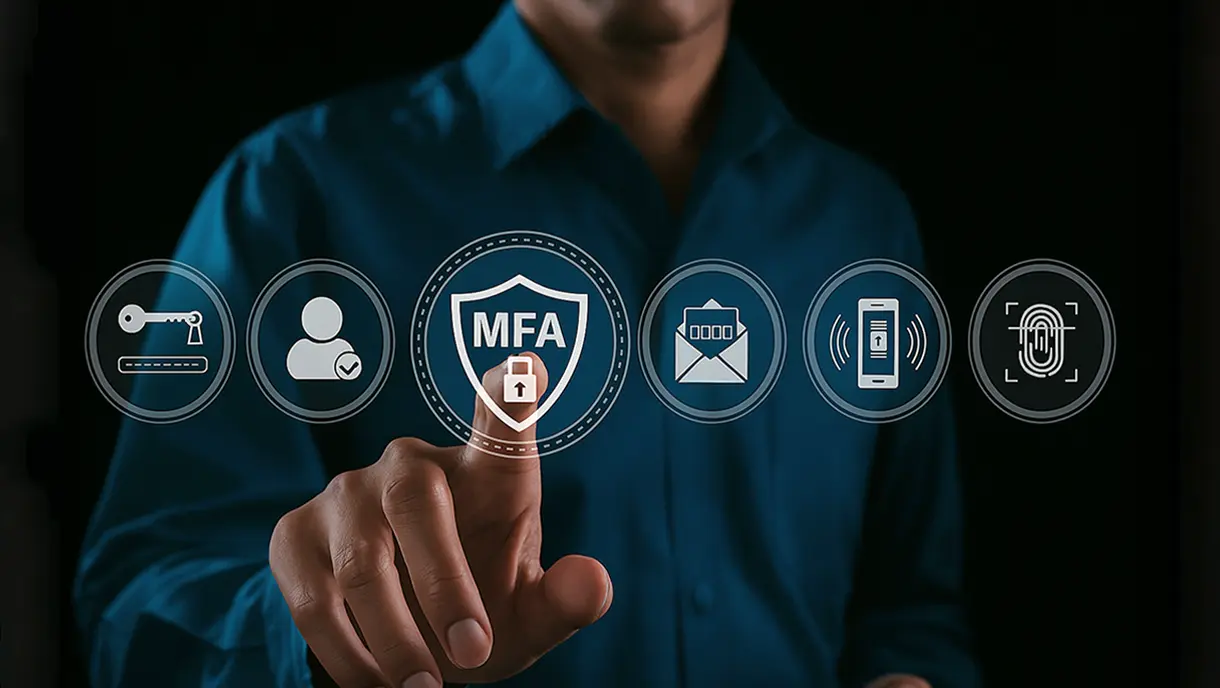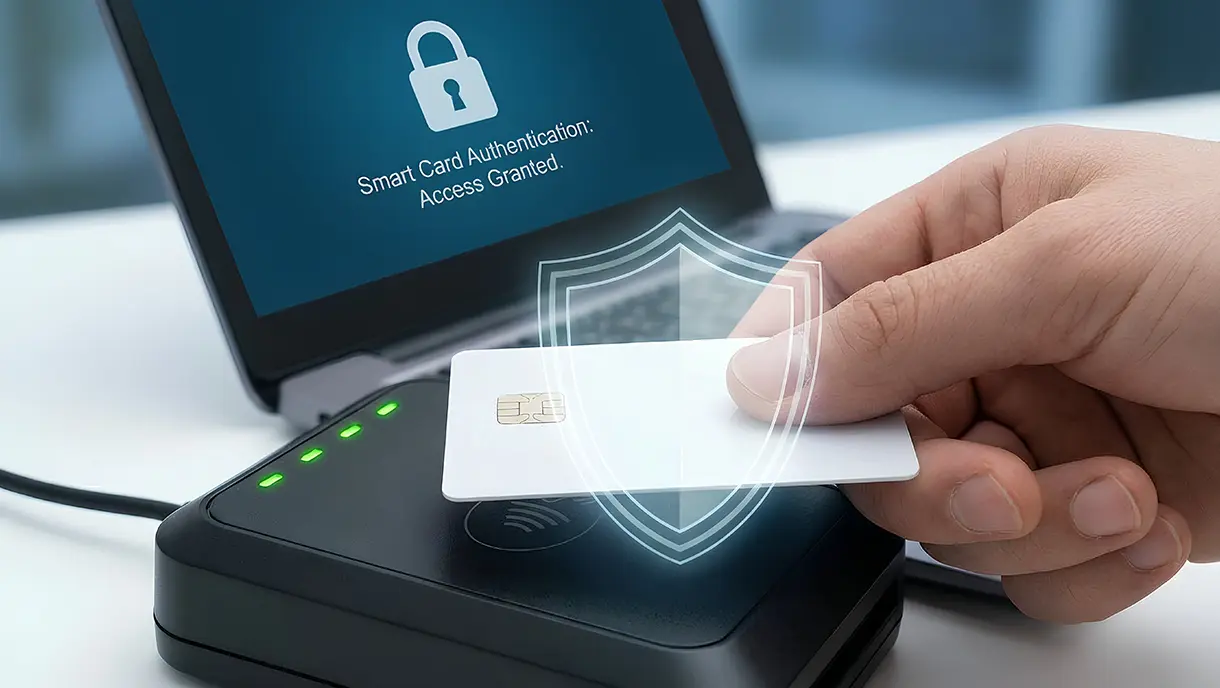10 Best Multi-Factor Authentication Solutions of 2025 [Latest Rankings]
Modern MFA solutions combine context-aware policies, biometric verification, and seamless integrations to prevent credential theft and unauthorized access. This detailed comparison of the 10 best MFA tools for 2025 examines each platform’s unique strengths, deployment options, and ROI. From Microsoft Entra ID to OLOID and Okta, you’ll discover which authentication solution aligns best with your organization’s growth, compliance, and Zero Trust security strategy.

As cyber threats grow more sophisticated, most organizations have already embraced Multi-Factor Authentication as a baseline for secure access. The challenge now isn’t whether to deploy multi-factor authentication; it’s choosing the right solution that balances security strength, user convenience, and scalability.
With dozens of vendors promising passwordless access, adaptive risk detection, and seamless integrations, it can be daunting to identify which one truly fits your business needs. Modern MFA platforms vary widely in their authentication methods, deployment models, and compatibility with existing IAM or SSO systems.
Selecting the right fit requires a closer look at each platform’s unique capabilities and real-world usability. To simplify your search, this blog compares the 10 best multi-factor authentication solutions of 2025.
We’ve analyzed the strengths, integrations, and best-fit use cases of the top MFA tools to help you pick the right one. You’ll also find a practical guide on the key factors to consider when evaluating MFA platforms, helping you choose a solution that’s both secure and future-ready.
How We Selected The Best MFA Tools of 2025
We followed a rigorous evaluation process to identify the most secure and scalable MFA tools for modern enterprises. We analyzed over 35 authentication platforms, comparing them across essential parameters that matter most to IT and security leaders.
1. Authentication Strength and Variety
We examined the range and robustness of authentication methods each solution supports, including FIDO2, biometrics, TOTP, and push notifications. Our goal was to highlight tools offering multiple layers of protection against phishing and credential theft.
2. Integration with SSO/IAM Systems
We evaluated the integration of each platform with identity management systems, including Okta, Azure AD, and Ping Identity. Strong integration ensures smoother workflows and centralized control for IT administrators. MFA works best when integrated into broader identity management platforms for unified access control.
3. User Experience and Accessibility
We prioritized solutions that provide a frictionless authentication flow for both employees and customers. Accessibility features and ease of use across devices played a key role in our evaluation.
4. Deployment Flexibility (Cloud, On-Prem, Hybrid)
We reviewed deployment options to ensure compatibility with diverse IT environments. The best MFA tools offer flexibility to meet the needs of cloud-first or hybrid infrastructure without compromising performance.
5. Total Cost and ROI
We compared pricing structures, licensing models, and long-term value for enterprises. Solutions delivering strong security outcomes at a reasonable total cost of ownership ranked highest on our list.
These parameters helped us narrow down the 10 best MFA solutions for 2025, ensuring each tool meets the evolving security, compliance, and usability needs of today’s organizations. Next, let’s compare the top MFA tools head-to-head.
Head-to-Head Comparison: 10 Best MFA Solutions in 2025
Here’s a head-to-head comparison to break down the best MFA solutions, evaluating their strengths, weaknesses, and ideal use cases. From enterprise-grade platforms to passwordless innovators, this comparison helps identify which tool aligns best with your organization’s security goals, compliance requirements, and user experience priorities.
[[cta]]
Detailed Overview of the Top MFA Platforms
1. Microsoft Entra ID
Best For: Enterprises using Microsoft 365 or Azure seeking deep integration, adaptive access, and unified identity management across hybrid environments.
Microsoft Entra ID, formerly known as Azure Active Directory, is a powerful identity and access management solution designed to secure hybrid and multi-cloud environments. It helps organizations protect users, devices, and data through advanced multi-factor authentication, conditional access, and identity governance features.
Entra ID integrates seamlessly with Microsoft 365, Azure, and thousands of third-party applications, ensuring consistent and secure access across all business systems. Built on Zero Trust principles, it empowers IT teams to strengthen authentication while maintaining a smooth user experience across the enterprise.
Key Features of Microsoft Entra ID
- Adaptive Access Controls: Enforces risk-based access policies using contextual signals like user location, device health, and behavior to ensure secure authentication.
- Seamless SSO Integration: Enables single sign-on across cloud and on-premises applications, improving user convenience while reducing credential sprawl.
- Phishing-Resistant MFA: Utilizes passwordless technologies, including FIDO2 keys, Windows Hello, and Microsoft Authenticator, for robust, user-friendly protection.
- Comprehensive Identity Governance: Provides lifecycle management, entitlement tracking, and compliance reporting for secure and auditable access control.
2. OLOID
Best For: Organizations transitioning to passwordless authentication, particularly those with frontline or shared-device workforces that require frictionless access control.
OLOID is redefining workforce authentication with a phishing-resistant MFA platform built to secure frontline workers. Unlike traditional MFA tools that rely heavily on mobile devices or OTPs, OLOID enables deviceless, frictionless authentication using secure identity factors like face recognition, badges, PINs, and NFC credentials. This approach eliminates common vulnerabilities such as password reuse and credential theft.
OLOID supports multiple authentication methods, including face recognition, NFC, QR codes, and palm biometrics, ensuring flexible, device-free access. Designed for industries such as manufacturing, healthcare, pharmaceuticals, retail, and call centres, this platform helps enterprises transition to a frictionless, phishing-resistant authentication environment that enhances both security and productivity.
A key differentiator for OLOID lies in its versatile deployment options and no-code integration capabilities. The platform adapts to diverse workplace setups with minimal friction. For organizations with distributed or high-turnover workforces, OLOID ensures fast, consistent, and secure access across devices and facilities, even in offline or shared environments.
Key Features of OLOID
- Passwordless Authentication: Enables secure login without passwords or tokens, reducing the risk of credential theft and simplifying access management.
- Seamless Integrations: Works with IAM platforms such as Okta, Microsoft Entra ID, Ping Identity, and ADP for unified identity governance.
- Phishing-Resistant MFA: Provides device-free and biometric-based verification methods to ensure strong identity assurance against modern threats.
- Frontline Workforce Focus: Optimized for industries like manufacturing, healthcare, and retail to enable fast, compliant access to shared workstations and apps.
User Reviews of OLOID
“OLOID's innovation has the potential to transform the hardware-centric access control industry into a software-as-a-service model with minimal capital expenditure.”
Managing Director
[[cta-2]]
3. Cisco Duo
Best For: Businesses adopting Zero Trust frameworks that need strong device trust, adaptive MFA, and phishing-resistant authentication methods.
Cisco Duo is a leading identity security platform designed to prevent identity-based attacks and enhance enterprise access controls. It combines multi-factor authentication, risk-based access, and unified identity intelligence to deliver a complete security-first IAM solution.
Cisco Duo helps organizations prevent phishing, credential theft, and unauthorized access by verifying both user identity and device health before granting access. With seamless deployment, adaptive policies, and robust phishing-resistant methods, it offers a balance of strong protection and a seamless user experience.
Key Features of Cisco Duo
- End-to-End Phishing Resistance: Protects against identity theft using passwordless and device-trust verification methods that eliminate vulnerabilities from traditional login credentials.
- Security-First IAM: Provides secure, timely access to sensitive data and applications through layered authentication and continuous device monitoring.
- Unified Identity Intelligence: Delivers deep visibility into who is accessing what, enabling faster threat detection and smarter security decisions.
- Zero Trust Network Access (ZTNA): Integrates identity-based security into network access, ensuring users and devices are continuously verified before connection.
4. Okta Adaptive MFA
Best For: Large enterprises wanting intelligent, context-aware MFA with seamless integration into diverse apps and cloud infrastructure.
Okta Adaptive Multi-Factor Authentication (MFA) is a leading enterprise identity platform that delivers secure, intelligent, and passwordless authentication across hybrid and cloud environments. Designed for both workforce and customer identity use cases, Okta seamlessly integrates with more than 7,000 business applications.
It supports a wide range of authentication methods, including biometrics, FIDO2 security keys, and device-based credentials. Its adaptive risk policies continuously evaluate device health, user behavior, and contextual data to ensure strong security without compromising the user experience.
Key Features of Okta Adaptive MFA
- Okta FastPass: Enables secure, passwordless authentication through device-bound credentials and biometric verification, allowing users to access all Okta-connected apps effortlessly without passwords.
- FIDO2 (WebAuthn) Authentication: Supports modern, hardware-backed authentication with devices like YubiKeys, Touch ID, and Windows Hello, ensuring compliance with the latest passwordless standards.
- Device Trust and Risk-Based Policies: Dynamically analyzes signals such as device posture, location, and user behavior to enforce adaptive authentication decisions in real time.
- Universal Directory and SSO Integration: Provides centralized identity management across cloud and on-premises systems, automatically provisioning credentials and syncing with HR or directory platforms.
5. Google Authenticator
Best For: Small teams and individuals needing quick, offline-capable TOTP-based authentication across multiple services.
Google Authenticator is a lightweight mobile app for iOS and Android that generates time-based one-time passwords (TOTP) to add an extra layer of security to your account. It creates unique six-digit codes every 30 seconds, ensuring secure logins even when users are offline.
Although the official app doesn’t offer a dedicated web version, users can utilize trusted third-party browser extensions to manage 2FA codes on desktop devices. Its simplicity, reliability, and offline operation make it a go-to authentication tool for both individuals and businesses looking to strengthen login protection.
Key Features of Google Authenticator
- Enhanced Account Security: Strengthens account protection with dynamic TOTP codes that safeguard against phishing and credential theft.
- Offline Code Generation: Works without any internet or network connection, generating secure verification codes locally on your device.
- Multi-Account Management: Supports multiple accounts within one app, simplifying access to different online services.
- Backup, Sync, and Browser Alternatives: Syncs code to your Google Account for recovery across devices, with optional browser extensions available for desktop convenience.
6. Ping Identity
Best For: Enterprises requiring centralized identity orchestration, adaptive MFA, and flexible deployment across complex hybrid and multi-cloud environments.
Ping Identity is an enterprise-grade identity platform that unifies access management, SSO, and multi-factor authentication under one umbrella. It supports both workforce and customer identity use cases.
The platform delivers adaptive authentication, context-aware risk policies, and deep integration with legacy and modern systems. Organizations leverage Ping Identity to enforce Zero Trust across hybrid environments, maintaining a seamless user experience.
Key Features of Ping Identity
- Broad Authentication Method Support: Offers mobile push, SMS, TOTP, QR codes, email OTPs, and FIDO2 biometrics across workforce and customer workflows.
- Adaptive Risk-Based Policies: Evaluates context like location, device state, and behavior to determine the level of additional authentication required.
- SSO and Identity Federation: Seamlessly connects with SSO and standards like SAML, OIDC, and SCIM for centralized identity management.
- Enterprise & API Integration: Offers RESTful APIs, inbound provisioning, and connectors to LDAP or legacy systems, supporting modern hybrid architectures.
7. LastPass
Best For: Companies already using LastPass that want to extend passwordless, adaptive MFA protection to apps, desktops, and VPNs.
LastPass MFA extends the core LastPass identity and password manager ecosystem with adaptive, passwordless multi-factor authentication capabilities. It offers a unified solution combining credential vaulting and access control.
Its design focuses on reducing friction while boosting security, especially for organizations already using LastPass’s password management services. LastPass MFA helps reduce reliance on passwords across apps, workstations, and VPNs.
Key Features of LastPass MFA
- Adaptive Authentication: Uses biometric data, location, device, and time-based risk signals to adjust authentication steps.
- Biometric & Face/Fingerprint Login: Supports face ID or fingerprint authentication, eliminating the need for passwords.
- Workstation & App MFA: Extends MFA protection to workstations, apps, VPNs, and identity provider integrations.
- Passwordless Experience & Easy Deployment: Offers simple roll-out guides and allows passwordless login to reduce user friction.
8. IBM Security Verify
Best For: Best for regulated enterprises seeking AI-driven MFA with built-in governance, contextual risk analysis, and lifecycle identity management capabilities.
IBM Security Verify is a comprehensive identity and access management suite that includes advanced MFA, governance, and risk-based access capabilities. It blends AI and contextual analysis to inform authentication decisions.
Whether managing hybrid or cloud environments, Verify offers flexible authentication across user types and applications. Its unified MFA approach aims to consolidate authentication across systems, simplifying security operations.
Key Features of IBM Security Verify
- Unified MFA Across Systems: Applies the same enrolled factors to Windows, Linux, VPN, web apps, and more.
- Adaptive Risk & Contextual Policies: Enables dynamic authentication based on user behavior, device, or location.
- Passwordless & Modern Methods: Supports FIDO2, passkeys, biometrics, and push-based login options.
- Identity Governance & Lifecycle Management: Manages user provisioning, role changes, and audit reporting.
9. PingOne MFA
Best For: Organizations embedding MFA directly into their applications with adaptive, API-driven, and frictionless authentication experiences.
PingOne MFA is a cloud-native authentication platform designed for seamless integration with web and mobile applications, providing strong verification capabilities. It focuses on blending user convenience with identity assurance.
With broad method support and adaptive policies, it helps organizations enforce MFA with minimal user disruption. PingOne is suitable for both internal workforce use and external customer access scenarios.
Key Features of PingOne MFA
- Rich Method Support: Accepts mobile push, email OTP, SMS OTP, TOTP, QR codes, magic links, and FIDO2 biometrics.
- Embedded MFA for Apps: Allows MFA flows directly within mobile or web apps via APIs and SDKs.
- Adaptive Authentication: Enforces stronger verification only under risk conditions, such as new devices or locations.
- Frictionless UX: Designed for smooth login experiences while maintaining strong security.
10. OneLogin MFA
Best For: Businesses using OneLogin SSO that want unified MFA coverage with simple, scalable, and adaptive access controls.
OneLogin MFA offers a streamlined multi-factor authentication solution integrated within the broader OneLogin identity and access platform. It is designed for fast adoption and ease of operation in enterprises.
OneLogin’s approach emphasizes simple MFA methods while providing strong security under a unified identity roof. It fits well in organizations already using OneLogin for SSO or user management.
Key Features of OneLogin MFA
- Multiple Authentication Options: Supports push approval, TOTP, biometrics, WebAuthn, and third-party authenticators.
- Seamless SSO Integration: Works naturally alongside OneLogin’s single sign-on environment for unified identity control.
- Adaptive Challenges: Dynamically elevates verification demands based on the risk context.
- Developer APIs & SDKs: Enables embedding MFA flows into custom apps and workflows with OneLogin’s identity APIs.
This concludes our list for the 10 leading multi-factor authentication solutions. Each solution offers its own balance of security strength, user experience, scalability, and integration flexibility. To help you make an informed decision, let’s look at the most important factors to consider when evaluating multi-factor authentication platforms for your organization.
8 Factors to Consider While Choosing a Multi-Factor Authentication Platform
Selecting the right MFA platform involves more than just comparing feature lists; it also requires evaluating the platform's overall capabilities and functionality. It’s about finding a solution that enhances your organization’s security posture while remaining easy to manage and use.
Here are eight essential factors to evaluate before making your choice.
1. Authentication Methods Supported
Opt for platforms that support a wide range of authentication methods, including biometrics, hardware security keys, OTPs, and push-based approvals. Having multiple options allows organizations to tailor authentication policies based on user roles, risk levels, and device types, ensuring both flexibility and strong protection.
Solutions like OLOID go a step further by offering deviceless and passwordless authentication options, such as facial recognition, badge, and NFC-based verification. Such platforms are ideal for shared-device and frontline environments.
2. Integration Capability
Your multi-factor authentication solution should integrate smoothly with existing systems such as SSO, IAM, HRMS, and legacy infrastructure. Deep integration reduces operational friction, streamlines identity management, and simplifies policy enforcement across diverse applications and cloud environments.
3. User Experience
The best MFA solution delivers security without disrupting daily workflows. Choose solutions that offer fast, intuitive, and frictionless login experiences while maintaining low false rejection rates. A user-friendly MFA platform improves adoption rates and reduces support tickets for IT teams.
4. Scalability
As your organization grows, your MFA solution must scale effortlessly. Ensure the platform supports large user bases, remote teams, hybrid work models, and frontline employees. Scalable architecture ensures consistent performance and security even during peak usage.
OLOID’s passwordless authentication platform, for instance, is designed to scale across enterprise environments without compromising speed or user experience.
5. Security Compliance
Compliance with legal frameworks isn’t optional; it’s a necessity. Select solutions that align with major frameworks, such as NIST, CISA, and GDPR. Platforms with built-in audit trails and reporting features facilitate the demonstration of compliance during security assessments and regulatory audits.
6. Deployment Options
Every organization has unique infrastructure preferences. Whether you rely on cloud-first systems, on-premise data centers, or hybrid environments, your MFA platform should adapt easily. Flexible deployment options ensure compatibility with existing workflows and security controls, providing seamless integration.
7. Cost and ROI
Beyond upfront pricing, consider long-term return on investment. Evaluate per-user costs, administrative efficiency, and potential savings from reduced breaches or password resets. A well-chosen MFA platform delivers both financial and security value over time.
8. Vendor Support & Updates
Reliable vendor support ensures smooth implementation and long-term success. Select providers recognized for their proactive updates, responsive customer service, and ongoing innovation to stay ahead of emerging threats.
Selecting the right multi-factor authentication solution is an investment in trust, security, and resilience. By carefully weighing factors, organizations can choose a solution that enhances security while providing users with secure and seamless access.
[[cta-3]]
Choose the Right Multi-Factor Authentication Solution for a Secure, Passwordless Future
In today’s threat-filled digital world, multi-factor authentication is no longer a luxury but a necessity. Cyberattacks are becoming increasingly targeted, and weak passwords remain one of the most common and easiest ways for attackers to gain access. MFA adds an essential layer of defense by verifying users through multiple checks, reducing the risk of stolen credentials and unauthorized access.
MFA is now essential for modern security and compliance. It protects organizations from phishing, credential theft, and data breaches while ensuring smooth, user-friendly access. The best solutions deliver phishing-resistant, frictionless authentication that keeps systems secure and employees productive.
Companies adopting advanced MFA today are preparing for a safer tomorrow. By investing in adaptive, passwordless technology, they strengthen their identity systems and build long-term resilience against evolving threats.
One standout provider is OLOID, known for its passwordless approach to authentication. It offers compliance-ready solutions, seamless integration with enterprise systems, and scalability to support growing workforces.
With OLOID, organizations can achieve stronger security while simplifying the user experience across all access points. Want to know more? Book a demo with OLOID’s team today to see it in action.
Frequently Asked Questions on Multi-Factor Authentication Tools
1. What is the most secure type of multi-factor authentication solution?
The most secure MFA solutions utilize phishing-resistant technologies, including FIDO2 hardware keys, biometrics, and device-based authentication. These methods eliminate the weaknesses of passwords and one-time codes by verifying both the user’s identity and device integrity. When combined with adaptive risk policies, they offer strong protection against phishing, credential theft, and session hijacking.
2. Which MFA platforms are best for enterprise or workforce authentication?
Top enterprise-grade or workforce authentication MFA platforms include Microsoft Entra ID, OLOID, Cisco Duo, Okta Adaptive MFA, and Ping Identity. These solutions are built for large organizations that need advanced access control, real-time threat monitoring, and flexible deployment options. They also integrate seamlessly with existing security ecosystems, making them ideal for managing diverse, global workforces.
3. Can these MFA solutions integrate with my existing IAM or SSO platform?
Yes. Most modern MFA platforms are designed for seamless integration with IAM and SSO tools, such as Okta, PingOne, and OneLogin. They support open standards, such as SAML, OIDC, and SCIM, to enable seamless interoperability across applications. This ensures organizations can enhance authentication security without disrupting existing user workflows.
4. Which MFA platforms are best for frontline workers?
Frontline teams need secure, fast, and convenient access from mobile or shared devices. Platforms like OLOID, Cisco Duo, and Google Authenticator offer lightweight, passwordless, and mobile-first authentication. These tools minimize friction while maintaining strong protection, making them ideal for retail, healthcare, and logistics environments.
5. What factors should I consider when choosing a multi-factor authentication provider?
When selecting an MFA provider, look for a balance between strong security, ease of use, and long-term scalability. The right solution should protect against modern threats while fitting seamlessly into your existing IT ecosystem.
Here are the key factors to evaluate:
- Authentication Strength: Choose solutions that support phishing-resistant methods such as FIDO2, biometrics, or device-based authentication.
- Integration Capability: Ensure compatibility with your IAM, SSO, and HR systems for smooth deployment and centralized management.
- User Experience: Seek frictionless login processes that enhance usability and minimize authentication fatigue for employees.
- Scalability: Select a platform that can grow with your workforce, including remote and hybrid teams.
- Compliance Readiness: Verify that the provider meets standards such as NIST, CISA, GDPR, and SOC 2.
- Cost and ROI: Evaluate total ownership cost, licensing flexibility, and efficiency gains over time.
- Vendor Support: Prioritize vendors offering consistent updates, proactive security improvements, and responsive technical support.






Get the latest updates! Subscribe now!




